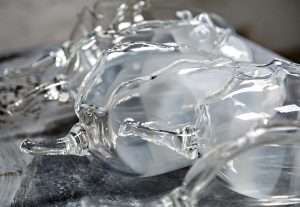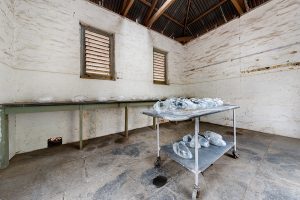In The Dead House: Adelaide Biennial of Australian Art, Art Gallery of South Australia

In the dead house, 2020
Hand blown glass bush bananas, vintage mortuary trolley
30 glass pieces, dimensions variable. Trolley 85 x 174 x 65cm

In the dead house, 2020
Hand blown glass bush bananas, vintage mortuary trolley
30 glass pieces, dimensions variable. Trolley 85 x 174 x 65cm

In the dead house, 2020
Hand blown glass bush bananas, vintage mortuary trolley
30 glass pieces, dimensions variable. Trolley 85 x 174 x 65cm

In the dead house, 2020
Hand blown glass bush bananas, vintage mortuary trolley
30 glass pieces, dimensions variable. Trolley 85 x 174 x 65cm

In the dead house, 2020
Hand blown glass bush bananas, vintage mortuary trolley
30 glass pieces, dimensions variable. Trolley 85 x 174 x 65cm

In the dead house, 2020
Hand blown glass bush bananas, vintage mortuary trolley
30 glass pieces, dimensions variable. Trolley 85 x 174 x 65cm

In the dead house, 2020
Hand blown glass bush bananas, vintage mortuary trolley
30 glass pieces, dimensions variable. Trolley 85 x 174 x 65cm

In the dead house, 2020
Hand blown glass bush bananas, vintage mortuary trolley
30 glass pieces, dimensions variable. Trolley 85 x 174 x 65cm

In the dead house, 2020
Hand blown glass bush bananas, vintage mortuary trolley
30 glass pieces, dimensions variable. Trolley 85 x 174 x 65cm

In the dead house, 2020
Hand blown glass bush bananas, vintage mortuary trolley
30 glass pieces, dimensions variable. Trolley 85 x 174 x 65cm
Yhonnie Scarce
29 Feb - 8 Jun 2020
Titled Monster Theatres, the 2020 Adelaide Biennial of Australian Art invites artists to make visible the monsters of our time. Curator Leigh Robb says ‘Monsters ask us to interrogate our relationships with each other, the environment and technology. They force us to question our empathy towards difference across race, gender, sexuality and spirituality’.
The term ‘monster’ comes from Latin monere, to warn, and monstrare, to show or make visible. The exhibition title hints at a double narrative which also resonates through the multiple meanings of ‘theatre’. An operating theatre is a room in which to examine, dissect as well as heal; it is also a theatre of war, a site of conflict where clashes between nations and ideologies play out all too frequently, but a theatre is also an arena – an active social space.
____
Yhonnie Scarce’s work In the dead house, 2020 will be exhibited in what was colloquially known as the dead house: an old stone mortuary in the Adelaide Botanic Gardens, attached to a hospital and psychiatric asylum. The work consists of 30 flayed bush bananas, made of blown glass with a smoky white opalescent colouring, mimicking the appearance of muscle sinew and the filmy appearance on corpses.
Yhonnie’s research unearthed the dead houses’ dark history, particularly in relation to coroner Ramsay Smith who worked in the mortuary in the early 1900’s.
Scarce says Ramsay Smith “had a very dark interest in decapitating deceased people, not just Aboriginal people but people that were vulnerable. He was known for interfering with corpses that were to be buried in the West Terrace cemetery. He was the main supplier of Aboriginal remains to universities and museums in the United Kingdom. I believe he was gaining from it financially”
“Who knew where else he was sending these remains? He could have been sending them all over the world. It’s quite dark and macabre.”
Despite being suspended from coronial duties in 1903, following charges of misusing human bodies, Ramsay Smith was cleared and his work in the mortuary continued. “I can’t speak for [all Aboriginal people] but from my point of view when the remains of your ancestors have been separated and sent all over the world, your spirit is not in one place and you’re not settled. It’s such disrespectful behaviour to human beings.”
The theme of Monster Theatres is apt, says Scarce. “As an Aboriginal person, we’re always being told to ‘get over it’, not to think about what happened in the past. But when you come across people who were colonising Australia who were killing Aboriginal people – people like Ramsay Smith, he was a monster,” she says.
“I think about death all the time, because I was raised to acknowledge what happened to our ancestors – so it’s not something that frightens me very much. But when you read about people like this man, he was incredibly horrible. You wonder where his brain was, playing around with these people. It’s like they were his toys. For me, that’s exactly what a monster is. He’s a serial killer in a different sense, really, waiting for people to die.”
— quotes from ‘Meth Kelly’ and colonial monsters: Australia’s biggest art shows get Indigenous rewrite’, written by Steve Dow for The Guardian, 25 Feb 2020
Images: Saul Steed
